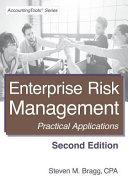
Enterprise Risk Management
Second Edition: Practical Applications
A well-run business needs to factor risk into its daily operations in order to keep from incurring unexpected losses. This book provides detailed guidance for doing so. Enterprise Risk Management describes the concept of risk management, how to identify risks, and how to prioritize the responses to these risks. The book also shows how to integrate risk management into an organization's strategy and day-to-day operations, and who is responsible for it. The book addresses risk management at the level of the individual functional area, including treasury and accounting, sales and marketing, human resources, and information technology. There is coverage of contingency planning, insurance, financial analysis, and risk-related measurements and reports. Risk management is a major failing in many organizations; use the planning advice in this book to rise above the crowd.
- ISBN 13 : 9781642210095
- ISBN 10 : 1642210099
- Judul : Enterprise Risk Management
- Sub Judul : Second Edition: Practical Applications
- Pengarang : Steven M. Bragg,
- Penerbit : Accountingtools, Incorporated
- Bahasa : en
- Tahun : 2018
- Halaman : 190
- Google Book : http://books.google.co.id/books?id=c-hkuAEACAAJ&dq=intitle:Enterprise+risk+Management&hl=&source=gbs_api
-
Ketersediaan :
This book provides detailed guidance for doing so. Enterprise Risk Management describes the concept of risk management, how to identify risks, and how to prioritize the responses to these risks.









